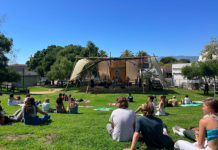Xander Apicella
Staff Writer
Yin Yu, a media arts and technology Ph.D student at UCSB, has designed a pre-college class entitled “In the Digital Age — Experiencing Architecture and Music Through STEM” that she will be teaching this summer. The class intends to break down the barriers between art and science for high school students.
Yu discovered these barriers as an electrical engineer in Silicon Valley, where she realized that she missed design and art.
Following this realization, she decided to go to architecture school because she viewed architecture as bridging art and technology.
She found inspiration in the work of Iannis Xenakis, a Greek-French composer and architect who worked with one of the world’s first computers to make music in the 1950s. His music spurred his architectural design. With the work of Xenakis as her inspiration, Yu began to experiment by incorporating her passion for electronic and digital music into her architecture.
After spending time in architecture school, Yu realized that engineering and architecture were both missing something.
“Engineers don’t really thinking about design or beauty. They just focus on the functions [and] the utility,” said Yu in an interview with The Bottom Line. “While working in an architecture firm, people are thinking about design, but people will not really use new technology. They are a little bit reluctant and scared.”
Coming to this conclusion drove her to combine the technical focus of engineering with the design focus of architecture through education.
To further this aim, Yu enrolled in UCSB’s media arts and technology (MAT) program, which immerses students in an interdisciplinary experience that combines media, engineering, programing, and art in order to contribute unique research and perspectives.
Yu and other MAT graduate students push towards creating synergy between art and technology. Due to the diverse influences on the MAT curriculum, the program has replaced the term STEM with the term THEMAS (Technology, Humanity, Engineering, Mathematics, Art, and Science).
Some educational institutions, such as the Rhode Island School of Design, have adjusted terminology to add art to the STEM curriculum, replacing the term STEM with STEAM (STEM + Art). However, UCSB’s MAT program goes one step further.
Yu was a TA for Professor Marcos Novak’s undergraduate THEMAS course, INT 80, in the winter and spring quarters of 2018.
After gaining interdisciplinary teaching experiences, Yu decided to create her own class based on her specific interests within THEMAS — architecture and music. Another reason why she chose these topics is because people are surrounded by them, making them familiar to almost everyone.
“We live in architecture all the time. This booth is architecture and this chair is architecture,” Yin said, gesturing around the interview location. She connected everyday sounds, like that of a door closing, to music.
She will use these understandings to teach her four-week summer course that is designed for high school students. These students face pressure to choose the “right” major and many may face pressure to major in a STEM discipline.
Yu’s course focuses on STEM concepts, while also breaking free of traditional STEM constraints.
The goal of the course is to develop a scientific intuition for architecture and music through the use of computational tools like 3D modeling and sound fabrication programs. Students will also explore more abstract concepts, like the role of soundtrack in a cinematic experience and the architectural flow of amusement parks.
The course will include a mixture of lectures by UCSB faculty and hands-on workshops.
Since Yu designed the course according to her own research interests, it will give students a glimpse into her unique, cross-sectional discipline as well as the opportunity to gain research and presentation experience. She intends to challenge her students’ preconceptions and open them to new experiences.
Yu views interdisciplinary understanding as vital to empowering students everywhere.
“In the future, we will design a better world, for us,” she said.


















gut
thanks you
Comments are closed.